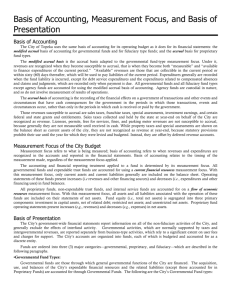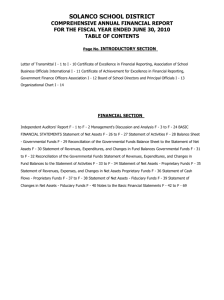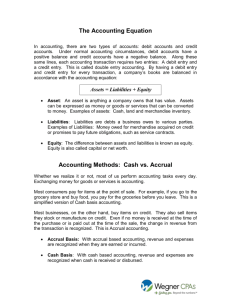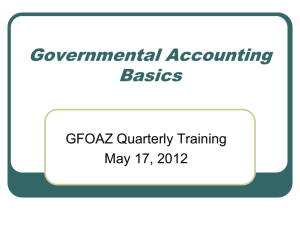Introduction to Governmental Accounting
advertisement
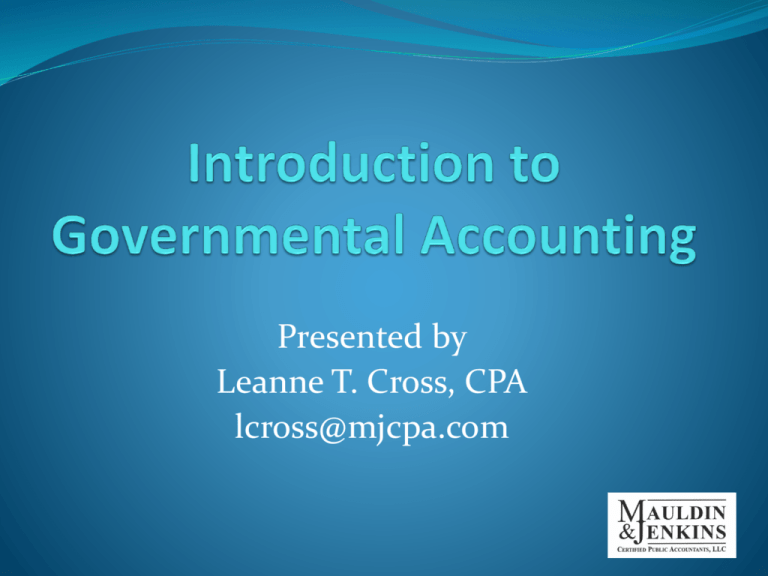
Presented by Leanne T. Cross, CPA lcross@mjcpa.com Governmental Acronyms FASB – Financial Accounting Standards Board GAAP – Generally Accepted Accounting Principles GASB – Governmental Accounting Standards Board RSI – Required Supplementary Information SLG – State and Local Government Characteristics of Government Absence of profit motive Owned by constituents – no stock Contributors of resources do not receive proportional share of benefits Decisions made – directly or indirectly – by voters Popular election of governing board Meetings where decisions are made open to the public Power to enact and enforce a tax levy Ability to issue tax-exempt debt Similarities to the Private Sector Operate in same economy and compete for same resources: financial, capital, and human Acquire and convert resources into goods and services Use of accounting and other information systems Need to operate economically, effectively, and efficiently Differences from Private Sector Organizational objectives Private Sector – maximize income from resources Government Sector – maximize services from resources Sources of financial resources Private Sector – raise resources from sales, capital stock, and debt transactions Government sector – raise resources from taxes, state appropriations, grants, and fees Methods of evaluating performance and operating results Differences from Private Sector (cont’d) Methods of evaluating performance and operating results Private Sector – continuing a product or service is determined by success in the marketplace Government Sector – Profit is not a motive Services are usually not found elsewhere so there is no competition Face rules and regulations not found in private sector Typical Activities of SLG Governmental Activities – unique to SLGs Police and fire protection Education Social services Courts Business-type Activities – similar to private sector Utilities Golf courses Airports Governmental Activities Purpose is to provide goods and services that all constituents need regardless of ability to pay for goods and services. Sources of Financial Resources Taxes – property, sales, and income Intergovernmental revenues – grants, revenue sharing Licenses and permits Fines and forfeitures Debt proceeds (typically not used for operations) Business-type Activities Purpose is to provide same types of services found in private sector. Source of Financial Resources Charge fee for services received Separate, self-sufficient operations Financial Report Users Citizens Legislative and oversight bodies Investors and creditors Financial Report Uses Comparing results with legally adopted budgets Assessing financial condition and results of operations Assisting in determining compliance with finance- related laws, rules, and regulations Assisting in evaluating efficiency and effectiveness Fundamentals of SLG Accounting and Financial Reporting GAAP and legal compliance Fund accounting Fund categories Types of funds Comparative financial statement formats among governments Annual financial reporting GAAP Reporting and Legal Compliance Ensures that all financial reports of all SLGs contain the same types of financial statements and disclosures for the same types of funds and activities Trying to assure comparability among and between governments Requires “full” disclosure Maintaining budgetary accounting control during the year. SLG GAAP Hierarchy GASB Statements and Interpretations, which are periodically incorporated into the Codification GASB Technical Bulletins and AICPA Audit Guides and SOPs if made applicable to SLG’s and cleared by GASB AICPA Practice Bulletins if made applicable to SLGs and cleared by GASB GASB staff Implementation Guides (Q&As) Fund Accounting Must understand fund structure, fund model, and interrelationships between funds Use of fund accounting allows for Proper accounting controls Demonstrating compliance Definition of a Fund Independent accounting entity with a self-balancing set of accounts A fund captures all reported attributes of a portion of the government’s activities and resources accounted for in that fund Fund Categories Proprietary funds Governmental funds Fiduciary funds Proprietary Funds Similar to accounting for businesses Accounting measures net position, changes in net position, and cash flows Types of Proprietary Funds Enterprise Funds – used to report activity for which a fee is charged to external users for goods and services. Customers are usually the general public, as well as businesses and other entities besides the government’s own department or agencies Activities required to reported in an enterprise fund if any one of the criteria on the following page are met: Types of Proprietary Funds (cont’d) Activity is financed with debt that is secured solely by a pledge of the net revenues from fees and charges of the activity. Laws or regulations that the activity’s costs of providing services, including capital costs, be recovered with fees and charges The pricing policies of the activity establish fees and charges designed to recover its costs, including capital costs. Types of Proprietary Funds (cont’d) Internal Service Funds – used to report any activity that provides goods or services to other funds, departments, or agencies of the primary government and its component units, or to other governments, on a cost-reimbursement basis. These funds should be used only if the reporting government is the predominant participant in the activity. Facilitate greater economy, efficiency, and effectiveness. Facilitate the equitable sharing of costs among departments. Proprietary Funds Measurement Focus Economic resources Financial statement recognition of all assets (current and noncurrent) and all liabilities (current and noncurrent) Basis of Accounting Accrual Recognize revenues when earned and expenses when incurred, regardless of the timing of related cash flows Proprietary Funds – Accounting Equation Current assets + Noncurrent assets + Deferred outflows Minus Current liabilities Long-term liabilities Deferred inflows Equals Net Position Statement of Revenue, Expenses, and Changes in Fund Net Position Operating revenues, net of uncollectible amounts Operating expenses = Operating income (loss) + or – Nonoperating revenues and expenses = Income (loss) before other rev, exp, and transfers + Capital contributions + Additions to permanent and term endowments + or - Special items + or - Extraordinary items + or - Transfers = Net increase (decrease) in fund net position + Fund net position – beginning of period = Fund net position – end of period Statement of Cash Flows Several differences from private sector Direct method required (FASB allows either method) Report all cash flows and balances – restricted and unrestricted cash and cash equivalents Noncash transactions reported on face of statement (FASB allows it to be reported in notes) Cash flows from operating activities Reflects only activities affecting operating income (FASB includes all transactions affecting net income) Excludes interest revenue and expense Statement of Cash Flows (cont’d) Cash Flows from Noncapital Financing Activities Debt issued to finance operations Transfers not related to capital acquisitions Cash Flows from Capital and Related Financing Activities Acquisition and sale of capital assets Issuance and repayment of debt, including interest, issued to acquire capital assets Transfers from other funds related to capital asset acquisitions Statement of Cash Flows (cont’d) Cash Flows from Investing Activities Acquisition and sale of investments Interest and dividends received Making and collecting loans (except operating loans) Noncash transactions Signing a capital lease Donated capital assets Unrealized gains/losses on investments Governmental Funds Used to account for sources, uses, and balances of general government resources Types of Governmental Funds General Fund – used to account and report all financial resources not accounted for and reported in other funds. Only fund for a general-purpose government. Special Revenue Funds – used to account for the proceeds of specific revenue sources that are restricted or committed to expenditures for specified purposes. Debt Service Funds – used to account for and report financial resources that are restricted, committed, or assigned to expenditure for principal and interest. Types of Governmental Funds (cont’d) Capital Projects Funds – used to account for and report financial resources that are restricted, committed, or assigned to expenditure for capital outlays, including the acquisition or construction of capital facilities or other capital assets Permanent Funds – used to account for resources that are legally restricted to the extent that only earnings, and not principal, may be used for purposes that support the reporting government’s programs – that is for the benefit of the government or its citizens. Governmental Funds Measurement Focus Current financial resources Financial statement recognition of current assets and current liabilities Basis of Accounting Modified accrual basis Revenues earned during or levied for the period, and are both measurable and available (usually within 60 days) Expenditures generally are recorded when a liability is incurred, as under accrual accounting, except for debt service expenditures, compensated absences, and claims and judgments which are recorded when due. Governmental Funds Accounting Equation Current assets+ Deferred outflows Minus Current liabilities Deferred inflows Equals fund balance Statement of Revenues, Expenditures, and Changes in Fund Balance Revenues Expenditures = Excess (deficiency) of revenues over (under) expenditures + Other financing sources (uses) + or - Special and extraordinary items = Net change in fund balance + Fund balance – beginning of period = Fund balance – end of period Fiduciary Funds Accounts for assets held by a government in a trustee or agency capacity for others Used to report assets that are not being held for the government’s own use Types of Fiduciary Funds Pension (and other employee benefit) Trust Funds – established to account for resources that are required to be held in trust for the members and beneficiaries of defined benefit pension plans, defined contribution plans, other post-employment benefit plans, etc. Investment Trust Funds – used to account for the external portion of investment pools held by the sponsoring government. Types of Fiduciary Funds (cont’d) Private-Purpose Trust Funds – used to account for all other trust arrangements under which principal and/or income benefit individuals or groups outside the government. Agency Funds – established to account for resources held in a purely custodial capacity for others. Only has assets and liabilities No additions or deductions Fiduciary Fund Measurement Focus Economic resources Financial statement recognition of all assets (current and noncurrent) and all liabilities (current and noncurrent) Basis of Accounting Accrual Recognize additions (not revenues) when earned and deductions (not expenses) when incurred, regardless of the timing of related cash flows Fiduciary Fund Accounting Equation Assets+ Deferred outflows Minus Liabilities Deferred inflows Equals net position Statement of Fiduciary Net Position = + = Additions Deductions Change in net position Net position – beginning of year Net position – end of year Questions In accounting for state and local governments, the modified accrual basis is required for: A. Proprietary and fiduciary funds. B. Governmental funds only. C. Proprietary funds only. D. All funds. Questions Which of the following funds is a governmental fundtype? A. Private-purpose trust fund. B. Internal service fund. C. Permanent fund. D. Enterprise fund. Questions Which of the following is a fiduciary fund? A. Investment trust fund. B. Special revenue fund. C. Debt service fund. D. Enterprise fund. Questions Which of the following funds would be most appropriate for accounting for an activity that provides goods or services to the public for a fee that is intended to make the activity self-supporting? A. Investment trust fund. B. Enterprise fund. C. Internal service fund. D. Special revenue fund. Questions Which of the following funds would be used to account for an activity that provides centralized purchasing and sales of goods or services to other departments or agencies of the governmental, or to other governments, on a cost-reimbursement basis? A. Enterprise fund. B. Fiduciary fund. C. Internal service fund. D. Permanent fund. Governmental Financial Reporting Basic Financial Statements GASB Statement 34 – Basis for Financial Reporting Issued in 1999 – marked a major change in financial reporting. Created dual perspective reporting Fund financial statements – detailed presentation Government-wide financial statements – consolidated overview Basic Government Financial Statements Overview Fund Financial Statements Government-wide Financial Statements ---------- Reconciliations - ---------Linked --Worksheets Governmental Funds Proprietary Funds Fiduciary Funds Governmental Activities Notes to the Financial Statements Business-type Activities Total Primary Government Annual Financial Reporting Annual Financial Reporting (cont’d) Minimum Reporting Requirements Management’s Discussion and Analysis Basic Financial Statements Government-wide financial statements Fund financial statements Notes to the financial statements Required Supplementary Information other than MD&A Annual Financial Reporting (cont’d) Primary Government Component Units Organizations for which the PG is financially accountable Other organizations whose omission would cause financial statements to be misleading. Annual Financial Reporting (cont’d) Government-wide Financial Statements Includes separate columns for governmental activities, business-type activities, total column for primary government, and discretely presented component units Fund Financial Statements Includes major funds individually and nonmajor funds in the aggregate Annual Financial Reporting (cont’d) Government-wide Financial Statements Statement of Net Position Statement of Activities Annual Financial Reporting (cont’d) Governmental Fund Statements Balance Sheet Statement of Revenues, Expenditures, and Changes in Fund Balance Statement of Revenues, Expenditures, and Changes in Fund Balance – Budget to Actual (may be either basic financial statement or RSI) If RSI, it is called a schedule, not a statement. Required for General Fund and major special revenues funds with a legally adopted budget. Annual Financial Reporting (cont’d) Proprietary Fund Financial Statements Statement of Net Position Statement of Revenues, Expenses, and Changes in Net Position Statement of Cash Flows Annual Financial Reporting (cont’d) Fiduciary Fund Statements Statement of Fiduciary Fund Net Position Statement of Changes in Fiduciary Fund Net Position Measurement Focus and Basis of Accounting Measurement Basis of Focus Accounting Government-wide Economic Accrual statements resources Governmental fund Current financial statements resources Proprietary fund Economic statements resources Fiduciary fund Economic statements resources Modified accrual Accrual Accrual Major Fund Reporting Governmental Funds Separate column for General Fund – always a major fund Each major fund Aggregate column for all nonmajor funds Total column required Reconciliations required (see sample) Major Fund Reporting (cont’d) Proprietary Funds Separate column for Each major Enterprise Fund Aggregate column for all nonmajor Enterprise Funds Enterprise Funds total column Single column for all Internal Service Funds – no major fund calculation for these type funds. Major Fund Reporting (cont’d) There is no major fund calculation for fiduciary funds. Fiduciary funds are reported in the aggregate by type (pension trust, investment trust, private-purpose trust, agency). Example – government has three pension trust funds and two private-purpose trust funds. There are only two columns in the basic financial statements – one column for pension trust funds, one column for privatepurpose trust funds, and a total column. Major Fund Determination All funds meeting the following criteria in the governmental and enterprise funds must be reported as a major fund (see sample) Total assets + deferred outflows or liabilities + deferred inflows or revenues or expenditures/expenses are at least 10% of the corresponding total for all funds of that category or type The same element that met the 10% test above is at least 5% of the corresponding element total for all governmental and enterprise funds combined. Other funds not passing the test can be reported as major funds at the option of the government (specific interest) Typical Government Transactions Expenditure/Expense Comparison Expenditures (net financial assets expended) Expenses (cost of goods or services used) Operating Salaries, supplies, utilities, etc. Salaries, supplies, utilities, etc. Capital outlay Acquisition Depreciation Debt service Principal and interest Interest Reporting Capital Assets Distinguish general capital assets from proprietary and fiduciary capital assets General capital assets Reported only in governmental activities of government-wide financial statements Proprietary capital assets Reported in both proprietary fund financial statements and government-wide financial statements Fiduciary capital assets Reported in fiduciary fund financial statements Reporting Capital Assets Valuation of Capital Assets Historical cost if purchased Estimated fair value for donated assets Depreciated over estimated useful lives Land Construction in progress Certain collections Infrastructure reported using the modified approach Reporting Capital Assets Recording capital assets Modified accrual Debit capital expenditures Credit cash/AP Accrual Debit property, plant, and equipment Credit cash/AP Debit depreciation expense Credit accumulated depreciation Reporting Capital Assets Sale of capital assets Modified accrual Debit cash Credit other financing source – proceeds from sale of capital assets Full accrual Debit cash Debit accumulated depreciation Credit capital asset Debit (Loss) or Credit (Gain) on sale of capital assets Recording Long-term Debt Issuance of debt Modified accrual Debit cash Debit bond issue costs (expenditure) Debit (other financing use – discount on issuance of debt) or credit (other financing source – premium on issuance of debt) Credit other financing sources – debt issued Accrual Debit cash Debit bond issue costs (expense) (post GASB 65) Credit long-term debt payable (liability) Recording Long-term Debt Recording long-term debt payments Modified accrual Debit principal expenditures Debit interest expenditures Credit cash Accrual Debit debt payable Debit interest expense Credit cash Modified Accrual Revenue Recognition Recognize only revenues susceptible to accrual – others on a cash basis. Requirements for susceptible to accrual Objectively measurable Available – collected in current period or soon enough thereafter to be used to pay liabilities of the current period. Legally usable to finance current period expenditures Establishing Legal Claim to Revenues Charges for services – performing the service Taxes – levy establishes claims to resources Sales taxes – business making a taxable sale Income taxes – taxpayer earning taxable wages Revenue Recognition Issue Asset recorded before meeting criteria to recognize revenue – must report either: Liability for unearned revenue Deferred inflow of resources Not available – not collected by year-end or soon enough thereafter. An imposed tax revenue levied (or otherwise imposed) to finance operations of a future year Collected in advance, and there is no performance obligation to earn the revenue. Nonexchange Transactions Derived tax revenues – Income and sales taxes Assets recognized when transaction occurs or resources are received, whichever is first Accrual – revenue recognized when the underlying exchange transaction occurs Modified accrual – same as above, but also when resources are available Imposed nonexchange revenues - Property taxes and fines and penalties Assets recognized when government has an enforceable legal claim or resources are received, whichever is first Accrual – in the period when use is required or first permitted by time requirements. Modified accrual – same as above, but also when resources are available. Nonexchange Transactions Government-mandated nonexchange transactions- services funded by higher level government Voluntary nonexchange transactions grants/entitlements from higher level government & certain private donations Assets – when all applicable eligibility requirements are met or resources are received, whichever is first Accrual – when all applicable eligibility requirements are met. Modified accrual – same as above, but when resources are available. Nonexchange Transactions Timing requirements - specify the period when resources are required to be used or when use may begin – affect when revenue is recognized. Purpose requirements – specify purpose for which resources are required to be used – do not affect timing of recognition “Reimbursement-type” and “expenditure-driven” grants are eligibility requirements – affects timing of recognition. There is no award until the recipient has met the requirements by incurring costs in accordance with provider’s program. Grant Received Before Earned Grant received Debit cash Credit unearned revenue Qualifying expenditures Expenditures Cash/AP Recognize revenue (for amount expended) Debit unearned revenue Credit revenue Grant Earned Before Received Before Earned Qualifying Expenditures Debit expenditures Credit Cash/AP Recognize revenue (equal to amount expended) Debit due from grantor Credit revenues Fund Balance Classifications Governmental Funds Nonspendable Restricted Committed Assigned Unassigned Nonspendable Fund Balance Represents amounts that cannot be spent Not in spendable form Inventory and prepaid items Long-term receivables and loans Property acquired for sale Legally or contractually required to be maintained intact – as in the principal of a Permanent Fund Amount in this classification should be determined before other classifications – may limit reporting in other classifications Restricted Fund Balance Constraints placed on the use of amounts are either: Externally imposed by creditors such as through debt covenants, grantors, contributors, or laws or regulations of other governments Imposed by law through constitutional provisions or enabling legislation Committed Fund Balance Amounts that can only be used for specific purposes pursuant to constraints imposed by formal action of the government’s highest level of decision-making authority should be reported as committed fund balance. Funds cannot be used for any other purpose unless the government removes or changes the commitment by taking the same action it employed to impose the commitment. Assigned Fund Balance Amounts that are intended by the government to be used for a particular purpose, but are neither restricted nor committed, should be reported as assigned fund balance. Intent should be expressed by governing body or a high-level body or official possessing the authority to assign resources to be used for specific purposes in accordance with policy established by the governing body. Assigned Fund Balance (cont’d) Residual category of fund balance for classification for any governmental fund other than the General Fund. Use in the General Fund indicates intent to use resources in manner that is narrower than general purpose of the government – cannot cause a deficit in the unassigned category. Unassigned Fund Balance Residual classification of the General Fund Only fund to report positive amounts is the General Fund. Negative amounts can be reported in other funds, but only after assigned amounts have been eliminated Fund Balance Classifications In General Fund, Unassigned may only be negative if Assigned is first eliminated. Net Position Classifications Net investment in capital assets Consists of capital assets, net of accumulated depreciation, reduced by the outstanding balances of any borrowings used for the acquisition, construction, or improvement of those assets. Excludes unspent debt proceeds. Restricted Net Position When there are limitations imposed on use of funds either through enabling legislation or through external restrictions imposed by creditors, grantors, laws, or regulations. Unrestricted Net Position – everything else Other Financing Sources/Uses Other Financing Sources Debt issued Premiums on debt issued Interfund transfers Sale of capital assets Insurance recoveries Other Financing Uses Interfund transfers Payments to refunding bond escrow agent Discounts on debt issued Other Financing Sources (cont’d) Interfund transfers Transferring fund Debit other financing use – transfer out Credit cash Receiving fund Debit cash Credit other financing source – transfer in Other Financing Sources (cont’d) Insurance recoveries Modified accrual Debit cash Credit other financing source insurance recoveries Accrual Debit cash Credit insurance recovery revenue Interfund Activity Nonreciprocal transactions Interfund reimbursements Interfund transfers Reciprocal transactions Interfund services provided and used Interfund loans Interfund Reimbursements Underlying event: Transaction initially recorded in one fund Should have been accounted for and reported in a different fund May also be used to distribute costs from one to others Accounting Remove expenditure/expense from the accounts of the fund in which it was initially recorded and record expenditure/expense in the reimbursing fund. Interfund Transfers Usually involves moving assets from one fund to another fund No expectation of repayment Accounting Record transfer in in one fund and record transfer out in another fund Interfund Services Sales and purchases of goods and services between funds for a price approximating fair value Accounting Seller fund sells goods or services (recognizes revenues) Buyer fund purchases goods or services (recognizes expenditures/expenses) Interfund Loan One fund loans cash to another fund Transaction does not change fund balance/net position. Accounting Lender recognizes a receivable Receiving fund recognizes a liability Interfund Loans (cont’d) Lender Fund Short-term loan – Due from other fund Long-term loan – Advance to other fund (will require separate reporting in fund balance) Receiving Fund Short-term loan – Due to other fund Long-term loan – Advance from other fund Extraordinary and Special Items Extraordinary Item Used by FASB and GASB Event is not under control of management and is both (1) unusual in nature and (2) infrequent in occurrence Special Item Unique to GASB Event is under control of management and is either unusual or infrequent Characteristics of Special Assessments Capital improvement financed by local government Sometimes long-term debt is issued to finance construction Special assessment pay principal and interest on bond issue Debt service funds used only if government is obligated in some manner on the debt If not obligated, government serves as conduit for payment, debt is not on government’s books, and Agency Fund is used for collection and subsequent payments Characteristics of Special Assessments (cont’d) Government plays two roles: General contractor to over see project Financing agent to provide interim financing for project and make collections for repayment of debt Most of receivables are noncurrent – come due in annual installments Levy is only for benefitted properties for special assessment work Characteristics of Special Assessments (cont’d) Revenue accounting follows same principles as fund levying assessment Proprietary fund – accrue receivable and revenue when final assessment is made Governmental fund – accrue receivable and deferred inflow As payments are made – Proprietary fund – debit cash/credit receivable Governmental fund – debit cash/credit receivable and debit deferred inflow/credit revenue Retiring Bonds Callable bonds Provision in outstanding bonds to retire them early Typically pay a premium to call bonds in addition to accrued interest and principal Refunding – using new bonds to substitute for old bonds Reasons for Advance Refunding Lower effective interest rates Extend maturity dates Revise payment schedules Remove or modify restrictions GASB Defines “Refunding” Issuing new debt whose proceeds are used to repay previously issued (“old”) debt Current refunding – new debt proceeds used to repay old debt immediately Advance refunding – new debt proceeds placed with escrow agent in an irrevocable trust and invested until used to pay old debt principal and interest in the future Defeased debt is removed from the government’s accounts and records and is no longer reported in the financial statements Defeasance - Transactions Modified Accrual Record refunding debt issue Record payment to refunded bond escrow agent Debit other financing use – payment to refunded bond escrow agent Credit cash Accrual Debit debt payable Debit (deferred outflow) or credit (deferred inflow) on refunding debt. Credit cash Proprietary Fund Transactions Intergovernmental Grants Capital grants restricted to construction, acquisition, or improvement of capital assets Reported on operating statement as capital contributions. Reported on cash flow as capital and related financing activities Operating grants are all other grants Reported on operating statement as nonoperating revenues. Reported on cash flow as noncapital financing activities Donations from Developers Occurs when a developer contributes infrastructure such as streets, water/sewer lines, etc. Accounting Transaction Debit Capital Asset Credit Capital Contributions Unbilled Revenues Represents revenues earned but not billed as part of the normal billing process – electricity sold, water used, etc. Accounting transactions Debit unbilled accounts receivable Credit operating revenues Bad Debts Bad debt expense is not recorded in proprietary funds. Accounting Transaction Debit operating revenue Credit allowance for uncollectible accounts Internal Service Funds - Billings Accounting transactions In the Internal Service Fund Debit due from General Fund Debit due from Enterprise Fund Credit revenues – billings to departments In the General Fund Debit operating expenditure Credit due to Internal Service Fund In the Enterprise Fund Debit operating expense Credit due to Internal Service Fund Internal Service Fund Net activity at year-end can be closed into governmental activities and/or business-type activities. Self Insurance Funds Governments have three options for reporting risk financing activities General Fund Special Revenue Fund Internal Service Fund Risk Financing Reported in General Fund or Special Revenue Fund All claims and judgments recorded in General Fund/Special Revenue Fund when due. Remainder of claims reported in government-wide statements. Amounts charged to other funds recorded as reduction of expenditures – reimbursements, not revenues Risk Financing Reported in Internal Service Funds All claims and judgments recorded in Internal Service Fund when incurred – may be current or long-term liability Amounts charged to other funds recorded as revenues Charges should be reasonable and equitable – preferably actuarially based – so that revenues and expenses are approximately equal. Budgets Budgets TRIM guidelines must be followed Usually approved by ordinance or resolution – refer to charter and/or code. Must be a balanced budget – beginning fund balance + estimated revenues + other financing sources – appropriations – other financing uses should be greater than or equal to $0. Per Florida Statute, expenditures should not exceed appropriations. Not required for all funds – statutory requirements. Budgets Should be tied to strategic plan Different types Operating Capital Capital improvement plan Cash Budget document serves as a financial plan, policy document, operations guide, and communication device. Budgets Level of budgetary control Legal level of budgetary control (fund, department, object) Administrative level of budgetary control Budgetary basis of accounting Expenditures only Expenditures and encumbrances Expenditures, encumbrances, and other basis Budgets Encumbrances Budgetary tool to control spending Purchase commitments Lapse vs. re-appropriation Budget Transactions Date Reference Vendor Description 10/1/2012 2013 Budget 12/1/2012 P.O. # 425 12/29/2012 P.O. #535 1/5/2013 Invoice 1025 1/15/2013 Invoice 50 3/31/2013 Budget Amendment Appropriations Encumbrances Expenditures 1,000,000 Office Depot Office Furniture Available 1,000,000 5,000 995,000 Dell Computer Computer Equipment 2,000 993,000 Dell Computer Computer Equipment (2,000) 2,000 993,000 Office Depot (5,000) 4,500 993,500 Office Furniture (500,000) 493,500


